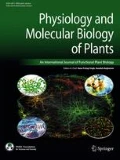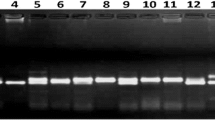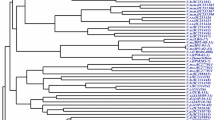Abstract
Plantain (Musa spp. AAB genome) is a major staple with an incredibly enormous potential for domestic and global trade that can serve as a vital source of income for many developing countries. The fruits are extraordinarily significant, providing an important and cheap source of dietary energy, vitamins, and several essential minerals to millions of consumers within the humid and sub-humid tropics. As molecular characterization is important for sustainable exploitation of crops, the extent of genetic and agro-morphological differentiation in a large Musa population of 109 accessions was evaluated using 10 microsatellite (SSR) markers and 14 morphotaxonomic descriptors, as a basis for selection of high yielding varieties. Measurement of DNA diversity delineated the plantains into 2 major groups and 8 distinct clusters, each with several sub-clusters. There was equally a very wide diversity detected in morphotaxonomic traits including pseudostem girth, number of bunches per plant, number of hands per bunch, number of fruits per bunch, number of fruits per hand, bunch weight, length of plant cycle, and flowering to harvest interval, which varied significantly (p < 0.05) amongst the accessions. Selection based on cluster analysis using standard morphological data also delineated the cultivars into 8 distinct clusters, with one of these containing samples that were most distant to all others and exhibited a 'double bunching' phenotype at fruiting; tacitly implying the presence of significant variability that symbolizes an excellent opportunity to bring about genetic improvement through selection of improved varieties. Principal component analysis based on morphotaxonomic traits revealed 7 attributes which contributed to 79.95% of total variation that was quite similar to the 71.87% detected using microsatellite fingerprinting. Correlation analysis between selected agronomic traits demonstrated that pseudostem girth was positively associated with bunch weight, number of hands per bunch, number of fruits per bunch, number of fruits per hand, and flowering to harvest interval across all accessions. Collectively, the data in this study suggest that plantain accessions with very unique traits expressing paramount horticultural significance are available within the diverse germplasm evaluated and are currently being collected for future breeding purposes to broaden the genetic base of this important crop.




Similar content being viewed by others
References
Agoreyo BO, Golden KD, Brown SE (2008) Analysis of genetic variability among plantain cultivars (Musa paradisiaca L) using arbitrarily primed PCR technique. Afr J Biotech 7:1041–1045
Brisibe EA, Ekanem NG (2019) Ploidy level and nucleotide variations in inflorescence dichotomous cultivars of Musa species (AAB genome). BMC Genomics 20:713. https://doi.org/10.1186/s12864-019-6083-5
Crouch JH, Vulysteke D, Ortiz R (1998a) Perspectives on the application of biotechnology to assist the genetic enhancement of plantain and banana (Musa spp.). J Biotechnol 1:1–18
Crouch HK, Crouch JH, Jarret RL, Cregan PB, Ortiz R (1998b) Segregation at microsatellite loci in haploid and diploid gametes of Musa. Crop Sci 38:211–217
Dzomeku BM, Bam R, Ankomah AA, Yeboah DK (2004) Preliminary study on the performance of some Musa hybrids in Ghana. J Ghana Sci Assoc 6:90–94
Ekanem NG, Brisibe EA (2018) Inflorescence developmental polymorphism and its horticultural significance in plantain (Musa spp. AAB genome). Afr J Biotech 17:1–8
FAO (2006) Production yearbook 2006. Food and Agriculture Organization, Rome, Italy
Gwag JG, Dixit A, Park YJ, Ma KH, Kwon SJ, Cho GT, Lee GA, Lee SY, Kang HK, Lee SH (2010) Assessment of genetic diversity and population structure in mungbean. Genes Genomics 32:299–308
Hippolyte I, Bakry F, Seguin M, Gardes L, Rivallan R, Risterucci AM, Jenny C, Perrier X, Carreel F, Argout X, Piffanelli P, Khan IA, Miller RNG, Pappas GJ, Mbe´guie´-A-Mbe´guie D, Matsumoto T, De Bernardinis V, Huttner E, Kilian A, Baurens FC, D’Hont A, Cote F, Courtois B, Glaszmann JC (2010) A saturated SSR/DArT linkage map of Musa acuminata addressing genome rearrangements among bananas. BMC Plant Biol 10:65. https://doi.org/10.1186/1471-2229-10-6
IBPGR (1988) International Board for Plant Genetic Resources. Lists for Quantitative and Qualitative Measurements of Growth and Yield Attributes in Plants, Rome, Italy
International Institute for Tropical Agriculture (2007) Plantain development trials in Ghana. IITA Res Bull 4:12–16
Jarret RL, Gawel N (1995) Molecular markers, genetic diversity and systematics in Musa. In: Gowen S (ed) Bananas and Plantains. Chapman and Hall, London, UK, pp 66–83
Kaemmer D, Afza R, Weising K, Kahl G, Novak FJ (1992) Oligonucleotide and amplification fingerprinting of wild species and cultivars of banana (Musa spp.). Biotechnology 10:1030–1035
Lagoda PJL, Noyer JL, Dambier D, Baurens FC, Grapin A, Lanaud C (1998) Sequence tagged microsatellite site (STMS) markers in Musaceae. Mol Ecol 7:657–666
Nei M (1978) Estimation of average heterozygosity and genetic distance from a small number of individuals. Genetics 89:583–590
Odeigah PGC (1997) “Double bunching” in a plantain germplasm in Nigeria: a new genotype. Genet Resour Crop Evol 44:1–3
Ogazi PO (1996) Plantain: production, processing, utilization pp.305. Paman and Associates Limited, Uku–Okigwe
Pennisi E (2010) Armed and dangerous. Science 327:804–805
Perrier X, Jacquemoud-Collet JP (2006) DARwin software https://darwin.cirad.fr/
Phillipe K, Ambang Z, Begoude D, Ten HM, KuataAmougou JA (2012) Evaluation of the sensitivity of two plantain varieties essong and big ebanga to the nematode Radopholus similis. Afr J Biotech 11:14755–14760
Saghai-Maroof MA, Soliman KM, Jorgenson RA, Allard RW (1984) Ribosomal DNA spacer length polymorphism in barley: Mendelian inheritance, chromosomal location and population dynamics. Proc Natl Acad Sci USA 81:8014–8018. https://doi.org/10.1073/pnas.81.24.8014
Ssebuliba R, Vuylsteke D, Hartman J, Makumbi D, Talengera D, Rubaihayo P, Magambo S, Nuwagala L, Nahamya P, Karamura E (2000) Towards improving highland bananas. Uganda J Agric Sci 5:36–38
Swennen R (1997) Plantain cultivation under West African conditions: a reference manual. International Institute for Tropical Agriculture, Ibadan, Nigeria, Amarin Printing Group Co. Ltd Thailand 24 p
Tenkouano A (2000) Persistence and horticultural value of inflorescence dichotomy in plantain. HortScience 35:933–936
Tezanas du Montcel H (1987) Plantain and bananas. Macmillan Publisher Ltd, London, UK, pp 4–6
Vuylsteke DR, Swennen RL, De Langhe EA (1996) Field performance of somaclonal variants of plantain (Musa spp., AAB Group). J Am Soc Hort Sci 121:42–46
Weising K, Nybom H, Wolff K, Kahl G (2005) DNA Fingerprinting in plants: principles, methods, and applications, 2nd edn. CRC Press, London
Author information
Authors and Affiliations
Contributions
EAB conceived the study, interpreted the data, and wrote the manuscript; MGU designed and performed experiments, and identified and maintained elite cultivars based on agronomic data.
Corresponding author
Ethics declarations
Conflict of interest
It is declared that there is no conflict of interest associated with the publication of this paper.
Additional information
Publisher's Note
Springer Nature remains neutral with regard to jurisdictional claims in published maps and institutional affiliations.
Rights and permissions
About this article
Cite this article
Brisibe, E.A., Ubi, G.M. Microsatellite fingerprinting and analysis of intra-population divergence in morphotaxonomic traits in a large Musa (AAB genome) germplasm. Physiol Mol Biol Plants 26, 1973–1988 (2020). https://doi.org/10.1007/s12298-020-00877-0
Received:
Revised:
Accepted:
Published:
Issue Date:
DOI: https://doi.org/10.1007/s12298-020-00877-0




